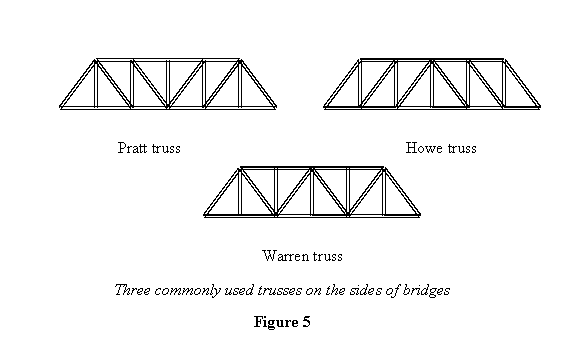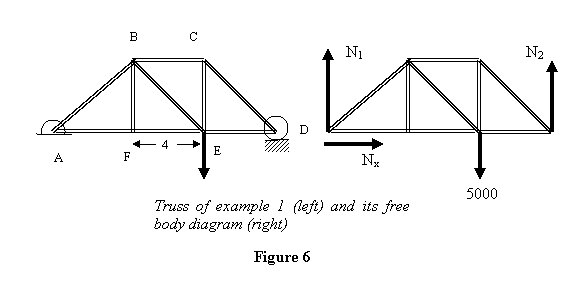Exercise 1: Shown in figure 5 are
three commonly used trusses on the sides of bridges.
Show that all three of them are simple trusses.

You may ask why we put trusses on bridges. As our
later analysis will show they distribute the load
over all elements and thereby making the bridge stronger.
We now wish to obtain the forces generated in various
arms of a truss when it is loaded externally. This
is done under the following assumptions:
- If the middle line of the members of a truss
meet at a point that point is taken as a pin
joint. This is a very god assumption because
as we have seen earlier while introducing a truss
(triangle with pin joint), the load is transferred
on to other member of the trusses so that forces
remain essentially collinear with the member.
- All external loads are applied on pin connections.
- All members' weight is equally divided on connecting
pins.
There are two methods of determining forces in the
members of a truss - Method of joints and method
of sections. We start with the method of joints:
Method of joints: In method of joints,
we look at the equilibrium of the pin at the joints.
Since the forces are concurrent at the pin, there
is no moment equation and only two equations for
equilibrium viz.  .
Therefore we start our analysis at a point where
one known load and at most two unknown forces are
there. The weight of each member is divided into
two halves and that is supported by each pin. To
an extent, we have already alluded to this method
while introducing trusses. Let us illustrate it by
two examples.
.
Therefore we start our analysis at a point where
one known load and at most two unknown forces are
there. The weight of each member is divided into
two halves and that is supported by each pin. To
an extent, we have already alluded to this method
while introducing trusses. Let us illustrate it by
two examples.
Example 1: As the first example,
I take truss ABCDEF as shown in figure 6 and load
it at point E by 5000N. The length of small members
of the truss is 4m and that of the diagonal members
is  m.
I will now find the forces in each member of this
truss assuming them to be weightless.
m.
I will now find the forces in each member of this
truss assuming them to be weightless.

We take each point to be a pin joint and start balancing
forces on each of the pins. Since pin E has an external
load of 5000N one may want to start from there. However,
E point has more than 2 unknown forces so we cannot
start at E. We therefore first treat the truss as
a whole and find reactions of ground at points A
and D because then at points A and D their will remain
only two unknown forces. The horizontal reaction Nx at
point A is zero because there is no external horizontal
force on the system. To find N2 I take
moment about A to get

which through equation  gives
gives

In method of joints, let us now start at pin A and
balance the various forces. We already anticipate
the direction and show their approximately at A (figure
7). All the angles that the diagonals make are 45° .

The
only equations we now have worry about are the force
balance equations.

Keep in mind that the force on the member AB and AF
going to be opposite to the forces on the pin ( Newton
's IIIrd law). Therefore force on member AB is compressive
(pushes pin A away) whereas that on AF is tensile
(pulls A towards itself).
Next I consider joint F where force AF is known and
two forces BF and FE are unknown. For pint F

Next I go to point B since now there are only two
unknown forces there. At point B

Negative sign shows that whereas we have shown FBE
to be compressive, it is actually tensile.

Next I consider point C and balance the forces there.
I have already anticipated the direction of the forces
and shown FCE to be tensile whereas FCD to
be compressive

Next I go to pin D where the normal reaction is  N
and balance forces there.
N
and balance forces there.

Thus forces in various members of the truss have been
determined. They are

You may be wondering how we got all the forces without
using equations at all joints. Recall that is how
we had obtained the statical determinacy condition.
We did not have to use all joints because already
we had treated the system as a whole and had gotten
two equations from there. So one joint - in this
case E - does not have to be analyzed. However, given
that the truss is statically determinate, all these
forces must balance at point E, where the load has
been applied, also. I will leave this as an exercise
for you. Next I ask how the situation would change
if each member of the truss had weight. Suppose each
members weighs 500N, then assuming that the load
is divided equally between two pins holding the member
the loading of the truss would appear as given in
figure 8 (loading due to the weight as shown in red).
Except at points A and D the loading due to the weight
is 750N; at the A and D points it is 500N.

Now the external reaction at each end will be.

The extra 2000N can be calculated either from the
moment equation or straightaway by realizing that
the new added weight is perfectly symmetric about
the centre of the truss and therefore will be equally
divided between the two supports. For balancing forces
at other pins, we follow the same procedure as above,
keeping in mind though that each pin now has an external
loading due to the weight of each member. I'll solve
for forces in some member of the truss. Looking at
pin A, we get

Next we move to point F and see that the forces are

One can similarly solve for other pins in the truss
and I leave that as an exercise for you.
Having demonstrated to you the method of joints, we
now move on to see the method of sections that directly
gives the force on a desired member of the truss.